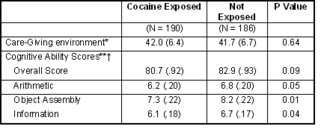Cocaine use during pregnancy results in exposure to a toxic substance during a key time in the neurolbiogical development of the fetus. The full effects of this exposure on, for example, the subsequent cognitive ability are unknown until the child is capable of more complex intellectual skills (Thadani, 1995; Vorhees, 1986) Therefore, a longitudinal study is necessary to isolate these effects. However, isolating the effects of cocaine exposure is difficult because the same exposure carries with it correlated problems within the child’s care-giving environment that also might interact with cognitive functioning (Richardson, 1996; Singer, 2001). This week’s STASH discusses a longitudinal study that examined the cognitive development and quality of the care-giving environment for cocaine exposed children from birth to four years of age.
Singer and colleagues’ (Singer, Minnes, & Short, 2004) conducted a longitudinal study that enrolled 415 participants pregnant women (281 cocaine positive and 197 cocaine negative) from an initial cohort of 647 identified by the researchers as at high-risk for cocaine use. Some women did not participate in the study because complete information could not be collected (n = 54), or they refused to participate (n = 155) or they did not show for initial interviews (n = 23). Researchers identified infants as cocaine exposed or not cocaine exposed based on biological specimens (e.g., urine screens for the mother, meconium samples for the infant) collected immediately after birth and maternal self-report of cocaine use during pregnancy. The researchers compared the demographics of the mothers of both groups of children, and information obtained at four years of age on measures of intelligence from the Wechsler Preschool and Primary Scales of Intelligence Test and measures of the quality of the care-giving environment obtained from interviews with the mothers or custodians using the Home Observation of the Environment: Preschool Version (HOME). Chi square tests and multivariate analyses tested the significance of the differences in cognitive ability and care-giving environment between groups defined by prenatal cocaine exposure (i.e., exposed versus not exposed). Researchers obtained assessments from 93% of the study participants at the 4-year follow-up period.
Mothers of the cocaine exposed children were less likely to be married, to have completed high school, or to have prenatal care; they were more likely to already have more children before they had the target child of the study. As Table 1 shows, there was no significant difference between overall cognitive ability and care-giving environment between the cocaine exposed and non-exposed children at four years of age. However, cocaine exposed children had significantly lower cognitive ability on three subscales (i.e., arithmetic, object assembly, and information skills).
Figure. Care-giving Environment and Cognitive Ability Scores for Children at 4 years of age (adapted from Singer et al.). Click image to enlarge. * Home observation of the Environment: Preschool version score (HOME) **Wechsler Preschool and Primary Scales of Intelligence Test scores. † Adjusted for HOME score, parity and caregiver characteristics. Click image to enlarge.
The authors made some conclusions about the effects the care-giving environment had on IQ scores of the children by comparing both groups of children foster or adoptive care to those living with their mothers. However, the number of children in this study placed in non-relative foster or adoptive care is small, so it is not possible to draw definitive conclusions about the effects of foster or adoptive care on the cognitive development of cocaine exposed children.
There were some limitations to this study. Many women who use cocaine also use other licit and illicit substances, and many at-risk mothers abuse other substances but not cocaine. For example, there is significant evidence that prenatal exposure to alcohol causes significant impairment in exposed children’s cognitive ability like fetal alcohol syndrome (Steinhausen, 1998). Therefore it is difficult for researchers to isolate the effects of cocaine without the contributing effects of exposure to other substances.
Despite these limitations, this study prospectively examined the long-term effects of prenatal cocaine exposure among a large cohort of high-risk children. Findings suggest that prenatal cocaine exposure is not associated with significantly lower overall cognitive ability at 4 years of age but is associated with significantly lower scores on three subscales of cognitive ability. This study did not examine the effects of support services for this high risk population. Future studies could examine effective early interventions and community programs designed to support biological mothers and foster/adoptive caregivers and their drug exposed children.
What do you think? Please use the comment link below to provide feedback on this article.
References
Richardson, G. A., Controy, M.L., Day, N.L. (1996). Prenatal cocaine exposure: effects on the development of school age children. Neurotoxical Teratol, 18, 627-634.
Singer, L. T. (2001). General Issues in Infant Assessment and Development. In L. T. Singer, Zeskind, P.S. (Ed.), Biobehavioral Assessment of the Infant (pp. 15-40). New York, NY: Guilford Press.
Singer, L. T., Minnes, S., & Short, S., et. al. (2004). Cognitive Outcomes of Preschool Children with Prenatal Cocaine Exposure. JAMA, 291(20), 2448-2455.
Steinhausen, H.-C., and Spohr, Hans-Ludwig. (1998). Long-term outcome of children with fetal alcohol syndrome: Psychopathology, behavior, and intelligence. Alcoholism: Clinical and Experimental Research, 22(2), 334-338.
Thadani, P. V. (1995). Biological Mechanisms and Prenatal Exposure to Drugs. Rockville, MD: National Institute on Drug Abuse.
Vorhees, C. V. (1986). Principles of Behavioral Tertiology. In E. P. Riley, Vorhees, C.V. (Ed.), Handbook of Behavioral Tertiology (pp. 23-48). New York, NY: Plenum.





